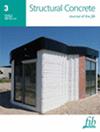高温暴露下钢-混凝土粘接强度的机器学习增强建模
IF 3.3
3区 工程技术
Q2 CONSTRUCTION & BUILDING TECHNOLOGY
引用次数: 0
摘要
本研究采用机器学习技术来研究各种高温情况下钢筋与混凝土之间的粘结强度。五种不同的机器学习算法,包括随机森林 (RF)、XGBoost、AdaBoost、决策树、线性回归和超参数优化,被用于预测粘接强度的变化。这些模型都使用 GridSearchCV 进行了严格的优化,以达到最佳性能。在这项研究中,我们评估了平均平方误差、均方根误差、平均绝对误差和判定系数 (R2) 分数等几个指标,以比较和评估模型的预测能力。优化后的结果表明,射频模型在估算不同温度条件下的粘接强度时表现出卓越的性能,误差极小,R2 分数很高。实际值和预测值的直观比较进一步证实了 RF 模型在捕捉粘接强度复杂波动方面的功效。这项研究的结果凸显了机器学习模型,特别是优化的 RF 方法在准确预测不同温度条件下的粘接强度方面的潜力,对工程和建筑实践具有重要意义。本文章由计算机程序翻译,如有差异,请以英文原文为准。
Machine learning enhanced modeling of steel‐concrete bond strength under elevated temperature exposure
This study uses machine learning techniques to investigate the bond strength between steel and concrete under various elevated temperature scenarios. Five distinct machine learning algorithms, including Random Forest (RF), XGBoost, AdaBoost, Decision Tree, Linear Regression, and hyperparameteric optimisations, were used to predict changes in bond strength. The models underwent rigorous optimisation using GridSearchCV to achieve optimal performance. In this study, we evaluated several metrics such as Mean Squared Error, Root Mean Squared Error, Mean Absolute Error, and coefficient of determination (R 2 ) Score to compare and assess the models' prediction capabilities. After optimisation, results indicate that the RF model exhibited exceptional performance in estimating bond strength across different temperature conditions, demonstrating minimal errors and a high R 2 Score. Visual comparisons of actual and predicted values further confirmed the efficacy of the RF model in capturing complex fluctuations in bond strength. The findings of this study underscore the potential of machine learning models, particularly the optimized RF method, in accurately predicting bond strength under varying thermal conditions, with promising implications for engineering and construction practices.
求助全文
通过发布文献求助,成功后即可免费获取论文全文。
去求助
来源期刊

Structural Concrete
CONSTRUCTION & BUILDING TECHNOLOGY-ENGINEERING, CIVIL
CiteScore
5.60
自引率
15.60%
发文量
284
审稿时长
3 months
期刊介绍:
Structural Concrete, the official journal of the fib, provides conceptual and procedural guidance in the field of concrete construction, and features peer-reviewed papers, keynote research and industry news covering all aspects of the design, construction, performance in service and demolition of concrete structures.
Main topics:
design, construction, performance in service, conservation (assessment, maintenance, strengthening) and demolition of concrete structures
research about the behaviour of concrete structures
development of design methods
fib Model Code
sustainability of concrete structures.
 求助内容:
求助内容: 应助结果提醒方式:
应助结果提醒方式:


